Explainer
- Explainer
- China relations
‘They want this, all of it’: The global arms race you can’t see – and China wants the edge
Microchips are key to powering the world. What will it take to win in this vital (and secretive) multi-billion-dollar world?
By Eryk Bagshaw, Jackson Graham and Daniel Ceng
The factories run 24/7. Outside, trees obscure the gas tanks that keep them pumping. Guards patrol the perimeter and ask us to delete photos of the buildings. Inside, rare machines perform exquisitely finicky tasks on a nanoscale. Canteens work overtime to feed thousands of specialist employees.
The tiny pieces of technology they’re making – advanced semiconductors, or microchips – are at the centre of a struggle between the United States and China that will help define the 21st century. The chip parts, tinier than viruses, are essential to the phone in your pocket, your car, your microwave. They will power not only the next generation of smart homes but also fighter jets and artificial intelligence.
Some 90 per cent of the world’s most advanced chips, including those used by Western powers, come from these factories a few hundred metres apart in Taiwan’s “Silicon Valley”, Hsinchu, just over an hour’s drive south-west of Taipei. Fierce competition among the tech giants, fuelled by an insatiable demand, keeps these sites running hot. “It’s winner takes all,” says Robert Tsao, the billionaire founder of one of the companies, United Microelectronics Corporation (UMC). But the industry, he says, needs to stay highly protected. “Otherwise, it could become a hostage.”
These chips are eye-wateringly costly and devilishly difficult to make, with pinch points along their supply chain. So essential is Hsinchu to the industry that even a short shutdown, such as after an earthquake, can put the industry on edge. What happens if these chips fall into the wrong hands? Why is there a race to produce them? Why have they become a flashpoint?
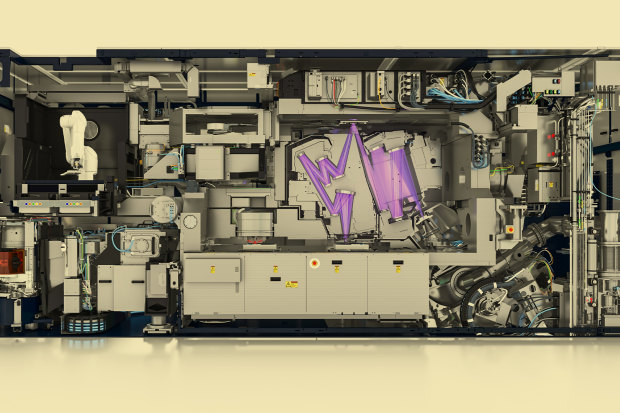
The light path inside a machine by Dutch company ASML conducts extreme ultraviolet lithography on a silicon wafer. Credit: ASML, digitally tinted
What’s a chip?
In 1956, three US scientists won a Nobel Prize for inventing transistors, tiny switches (then a centimetre long) that improved on earlier valve technology to become a mainstay of electronics. Two years later, engineers Jack Kilby and Robert Noyce realised electronic systems could be enhanced when many transistors were arranged on what’s called an integrated circuit. (Kilby accepted a Nobel for that breakthrough in 2000.) The transistors have become ever tinier and, therefore, can be packed more densely onto the surface of a chip. “Higher density means increased speed and reduced power consumption,” says Lan Fu, head of electronic materials engineering at ANU.
Today, tech companies refer to differences in their chips in nanometres. One nanometre is a billionth of a metre (a grain of rice is 5 million nanometres long.) The Apple iPhone 15 has a “three-nanometre chip”, while the iPhone 14 has a “five-nanometre chip”. The differences reflect generations of computing power rather than an actual measurement on a chip.
“Basically, we are faster, smaller and more powerful,” says Bobby, a research and development engineer we speak with from one of the three companies in Hsinchu, TSMC (Taiwan Semiconductor Manufacturing Company), which manufactures chips for Apple. (Like many workers we spoke with for this story, Bobby requested to be identified by a pseudonym to protect his employment.)
China’s largest chip producer, the Semiconductor Manufacturing International Corporation (SMIC), is lagging behind the Taiwanese leaders. Beijing has pumped more than $36 billion into SMIC over the past three years, hoping to produce five-nanometre chips by as early as this year, according to the Financial Times.
‘A single rogue atom in the wrong place means ... your silicon chip fails. It is one of the purest things that humankind is capable of making.’
Author Ed Conway
Nowadays, the US makes only a small number of chips. Most US companies send designs to manufacturers overseas, largely in Taiwan and South Korea. The chips can have up to 100 layers; one company involved in making them, ASML, likens them to tiny skyscrapers, thanks to their 3D grids of billions of transistors, which switch on or off to process the lines of zeroes and ones generated by computing code.
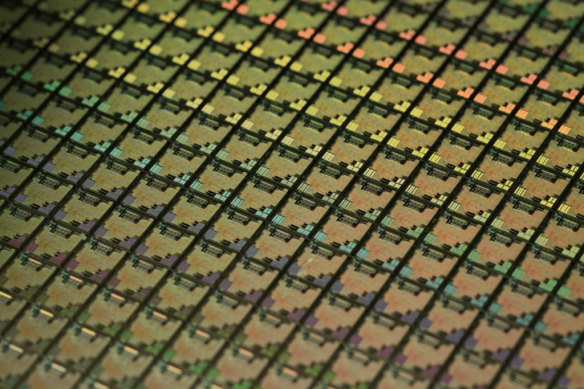
A 12-inch wafer at a TSMC fabrication plant.Credit: TMSC, digitally tinted
Building the chips is an elaborate process. High-quality quartzite is purified by heating it to 1500 degrees and then put through a different heating process to make super-pure polysilicon, says Ed Conway, author of Material World, a book about six of the substances that will shape the future. “The whole point of silicon chips is they need to be incredibly pure,” Conway tells us from London. “A single rogue atom in the wrong place means that your electrical current can’t go through, and therefore, your silicon chip fails. It is one of the purest things that humankind is capable of making.”
But that’s not all. The second stage of heating is done in a crucible, a bowl-shaped container made from a particularly special type of purified quartzite that only one mining district produces in large quantities: Spruce Pine, North Carolina. “Pretty much every microchip in the world will have come into contact, shall we say, with a Spruce Pine crucible,” Conway says. “If this place goes down, we’re all in big trouble.”
Once the silicon cools, a diamond saw slices the “sausage” into circular wafers that go to “fabs”, or fabrication plants. Taiwan has the lion’s share of fabs that produce “logic” chips – the systems that run smartphones and computers – while South Korea’s facilities build more than half of the world’s memory chips, which store data. The fabs have machines that imprint the shapes of the tiny transistors on each wafer, a process called photolithography. Put simply, a machine shoots light at sensitive chemicals to make patterns on the silicon.
Most of the key chemicals in this process are from Japan, and the most advanced of these machines are made by one company, ASML, in the Netherlands. “If there were a vast flood in the Netherlands that knocked out that production facility, the machines that make chips would be delayed, and therefore chips would be delayed,” says Chris Miller, author of Chip War: The Fight for the World’s Most Critical Technology. Taiwan is earthquake prone. TSMC and UMC paused plants on the west coast after a 7.2-magnitude quake in April, leading analysts to point out even a “hiccup” could delay shipments and cause millions of dollars in unexpected costs.
Miller, an associate professor of international history at Tufts University, has visited a fab. People wear hazmat suits in pristine surrounds – a speck of dirt can ruin a silicon chip. “It’s one of the least human environments you can be in; it’s just mostly robots, and the people who are there are completely covered up as you can barely make out who they are,” he tells us from New York. “All of the manufacturing is happening at a scale that is far smaller than the human eye [can see].”
‘Unless you’re already in mass production, you just can’t do it yourself – it will be too risky. Maybe even crazy.’
Chip tycoon Robert Tsao
Ed Conway says part of the success of the leading fabs, such as those in Hsinchu, is that they can ensure a high percentage of their transistors work properly. “What that underlines is being good at making chips … is not just about having the right tools, the right machines and the right buildings; it’s about running manufacturing plants,” he says.
UMC founder Robert Tsao puts it like this: “The amount of money needed to upgrade technology and equipment is huge. For a high-end semiconductor used in a car, making one piece will take half-a-billion dollars. So, unless you’re already in mass production, you just can’t do it yourself – it will be too risky. Maybe even crazy.”
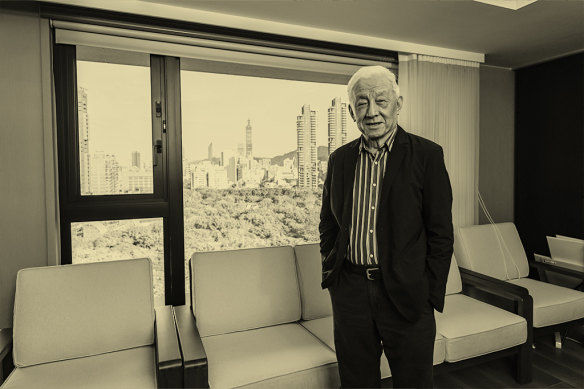
Billionaire chip pioneer Robert Tsao in his office in Taipei.Credit: Daniel Ceng, digitally tinted
All of this investment has made the industry highly secretive.
No personal devices are allowed inside TSMC, for example. Each employee is issued with a company phone. The phone has its photo and storage capabilities disabled. It has only one ringtone. On weekends, when employees “on call” are at Hsinchu’s Big City shopping centre, many check their pockets to see if theirs is the one ringing.
“It is high pressure,” says Steven, a mask data integration engineer at TSMC. “We make products for major clients such as Apple. I joke with my friends that maybe you can buy more iPhones so that my salary will increase.” He says the maximum number of errors allowed in chip production is three per day. Any more, and pay can be docked; performance-based bonuses make up two-thirds of wages.
TSMC said its annual employee turnover rate was 6.7 per cent and that it encouraged staff to maintain a work-life balance. “TSMC is in one of the most competitive industries in the world. In recent years, we have pushed our technology to a world-leading position,” a spokesperson said. “It is not easy to maintain this position, but the company believes that while hard work is necessary, work is only one part of life.”
Another worker, Bobby, in research and development at TSMC, says the pressure is worth it. Taiwan’s universities churn out specialised graduates who are hoovered up by the chip companies, future-proofing the industry. Employees fresh out of uni earn $70,000 a year while those with a PhD take home $100,000 – far more than Taiwan’s average annual wage of $33,000. “The technology industry is an oasis in a generally low-paid country,” Bobby says.

Taiwan makes 90 per cent of the world’s most advanced chips. Credit: Getty Images, digitally tinted
Why are chips a flashpoint for the US and China?
“Chips are the new oil, and America is spending billions to safeguard its supply,” declared The Wall Street Journal in 2023. Chips are often described in this way, and the comparison with oil isn’t far off the mark, says Greg Allen at the Centre for Strategic and International Studies in Washington. Much of the production of the crude black goop that comes out of the ground is concentrated in a few hands, yet demand for it is global. “In the case of semiconductors, this used to be an industry that didn’t think a tonne about politics,” says Allen. “That era is profoundly over; semiconductors are a deeply geopolitically relevant industry.”
‘Semiconductors were invented in America … But today, the United States produces less than 10 per cent of global supply and none of the most advanced chips.’
US President Joe Biden
In February, President Joe Biden announced the US would invest almost $8 billion in chip research and development. “Semiconductors were invented in America and serve as the backbone of the modern economy,” Biden said in a statement. “But today, the United States produces less than 10 per cent of global supply and none of the most advanced chips.”
The US wants to wrestle back 20 per cent of the production of these chips by the end of this decade – a target its commerce secretary, Gina Raimondo, confirmed in February. Analysts are weighing whether that’s achievable. “Part of the reason why Korea and Taiwan occupy the position that they do in the semiconductor industry is they can invest rain or shine,” Allen says. “It’s because these $US20-billion ($30bn) facilities take two or three years to bring online. And that’s the one question I have for the United States in this area: ‘If your goal is 20 per cent, are you really prepared to invest that?’”
TSMC has pledged to build a $60 billion, four-square-kilometre fab in Arizona, but it has been plagued by delays; its 2026 opening has now been pushed back until 2027 or 2028. “There will be a gap,” chairman Mark Liu told investors in January. The company has also poured $30 billion into Japan, opening its first fab there in February and announcing plans for a second by the end of 2027, and is looking to build a fab in Germany.
China’s economy has boomed off the back of tech companies such as Huawei, Tencent and Xiami but all of them have relied, to an extent, on chip technology made in Taiwan and the West. In 2018, China’s President Xi Jinping told Chinese chip firm YMTC that developing chips was as important for China’s technology sector as hearts are for humans. “When your heart isn’t strong, no matter how big you are, you’re not really strong,” he said.
Artificial intelligence has upped the stakes. China has said it wants to be the leader in AI by 2030. “Over the next decade, or two or three decades, we expect pretty much everything in military affairs is going to involve artificial intelligence to some extent,” says Allen. As director of the US Defence Department’s Joint Artificial Intelligence Centre in 2021 and 2022, he was “the guy” tasked with sparking talks with China about a responsible future for AI. “We made this request [for talks] multiple times to the Chinese military,” he says. “And the answer was ‘no’ every time.”
In 2022, the US government took a major step: it banned the export to China of advanced US chip technology used in artificial intelligence and for military purposes. “It actively sought to degrade the technological state of the art in China,” says Allen. “That was a deviation from the past 25 years.” The subtext of the ban: “When you say to China you’re no longer going to be able to purchase the most advanced US-made AI chips; you’re essentially saying to China, ‘The United States and our allies are going to the future, the future is going to be powered by AI – and we don’t want you to come.’”
The bans didn’t completely stop China from smuggling in chips. In 2023, Reuters reported that buyers could purchase a small number of chips designed by US company Nvidia in electronics districts in Shenzhen, although the chips were $US20,000, double the usual price. Foreign Policy reported that potentially 40,000 to 50,000 banned chips had found their way into China via neighbouring countries.
In November, new US laws closed some loopholes in its bans. By January, the Dutch company ASML cancelled three shipments of its machines to China after it had its export licence revoked by the Dutch government. China’s Foreign Ministry spokesman Wang Wenbin said: “The US needs to stop politicising and weaponising trade and tech issues and stop destabilising global industrial and supply chains.”
‘In a chip race, the leader cannot afford to trip, even once.’
Dan Hutcheson of TechInsights
The Pentagon, meanwhile, plans to field thousands of “autonomous systems”, run by AI, such as drones to counter China by 2026. “But it’s not only that,” says Chip War’s Miller. “There has been, for some time, the application of AI to electronic warfare systems to jam your opponent’s communications and keep yours open. As AI gets more sophisticated, so too will electronic warfare.”
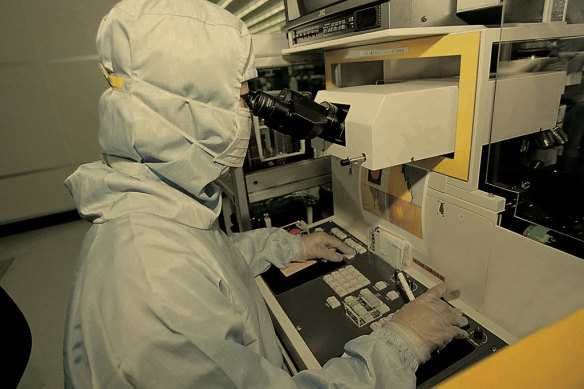
Highly specialised graduates work in fabs such as this one, owned by TSMC.Credit: TSMC, digitally tinted
The most advanced chips the US has banned from entering China, Nvidia’s GPUs, were originally developed for video games. “That is why you’ve had this intermingling of civilian and military concerns with the chip industry,” says Miller. Nvidia, based in California’s Silicon Valley, recently made headlines when it pushed stockmarkets in the US, Europe and Japan to record highs as it became the US’s third most valuable company after Apple and Microsoft.
Although chips are small and lightweight, the vast quantities needed to train AI systems are unlikely to circumvent the bans, say experts we spoke with. “Chinese companies are definitely complaining about access to chips,” Allen says. Miller thinks the bans are unlikely to stop China’s progress on AI, only slow it. UMC’s Tsao doesn’t believe China will catch up. “Because so much technology has been accumulated outside China. As a newcomer, it’s too late.”
Either way, the speed at which Taiwan and the West can outpace China is slowing because they are running out of space. There are only so many transistors – even if they are smaller than 1/500,000 of a grain of sand – that can fit on a chip. TSMC and other industry leaders are now experimenting with ways to revolutionise the packaging of semiconductors and stack more transistors on top of one another.
“It’s harder to run faster than the fastest one of the group. But once the fastest one can’t run any faster, then others catch up to it,” Dan Hutcheson, the vice chair of Canadian semiconductor research firm TechInsights, told Nikkei Asia in December. “In a chip race, the leader cannot afford to trip, even once.”
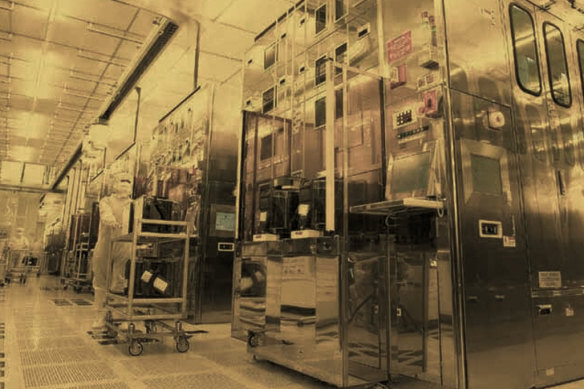
Workers wear hazmat suits in fabrication plants such as this one owned by TSMC.Credit: TSMC, digitally tinted
Why is it said chips are a silicon shield for Taiwan?
Up to half of the world’s shipping passes through the Taiwan Strait, the narrow strip of water that separates the democratic island from mainland China. Communist China has never ruled Taiwan, but Beijing claims the island as its own. About 6 per cent of Taiwanese voters were in favour of ever unifying with China, according to National Chengchi University’s 2023 poll, down from 12 per cent in 2018. Undeterred, Xi has repeatedly vowed to unify the mainland and the island “by force if necessary”.
“They have to think hard about it because it will cause a $3-trillion loss to the world economy,” says Tsao when we meet in his office in Taipei. The 76-year-old has small red and green tattoos on his middle fingers. They read 知 定 or Zhi-Ding, the belief that restraint will pave the way for concentration and eventually, tranquility. Tsao’s philosophy is Taoist, but his economics is more Adam Smith, the Scottish economist who wrote The Wealth of Nations and laid the foundation for modern free markets based on specialisation.
Taiwan’s exports were once concentrated in manufacturing, steel and petrochemicals, but a breakfast meeting at a local soy milk restaurant changed all that. In 1974, US-educated electrical engineer Pan Wen-yuan suggested to the minister of economic affairs, Sun Yun-suan, that Taiwan should invest in the chip technology he had been studying. The chips being made in the US were for digital watches, but while Radio Corporation of America (RCA) had developed the technology, their production lines were slow and inefficient. After investing $15 million, the Taiwanese government signed a technology transfer deal with RCA in 1976.
Tsao, an electrical engineering and management graduate from National Taiwan University, was one of the first trainees to travel to the US to study the chip manufacturing process. The chips were soon being used in much more than watches. Tsao saw their potential value, and the government invested heavily in his company, UMC, as well as in TSMC. The plan worked. By 2020, Taiwan’s chip industry accounted for half of all global foundry revenue. Now worth $221 billion a year, its strength is sometimes referred to as a “silicon shield” because the ubiquity of chips makes actions that threaten Taiwan’s factories too consequential to the world economy, from which China would not be immune.
Nor would the rest of the world. During the COVID-19 pandemic, a surge in demand from workers at home coupled with restricted shipping meant it took a record 15 weeks for chip orders to be filled. Not only did this have “first world” effects, slowing the delivery of new Volkswagen cars and limiting sales on PlayStations, but it also threatened the manufacturing of medical devices and hospital systems.“If we fail to take immediate action to address this shortage, it will impact patients in all corners of the world,” the World Economic Forum warned. President Joe Biden’s top economic adviser said the pandemic chip shortage probably wiped a full percentage point off US GDP in 2021.
‘No country can do it independently of other suppliers. It’s a global orchestra, and the United States is the conductor.’
Robert Tsao
The same year, Taiwan’s President Tsai Ing-wen said the island’s role as a key node in the world’s electronic supply chain meant it had to be protected. “Our semiconductor industry is especially significant: a ‘silicon shield’ that allows Taiwan to protect itself and others from aggressive attempts by authoritarian regimes to disrupt global supply chains,” she wrote in Foreign Affairs. (Tsai’s vice president, Lai Ching-te, will take office in May after the Democratic Progressive Party was elected for a third term.)
Tsao worries about the industry’s vulnerability – two years ago, he donated millions of dollars to an academy for citizen defence training such as first aid – and says the chip industry could become less of a shield and more of a hostage in Beijing’s negotiations with other countries over Taiwan. “They might say: If you keep supporting Taiwan, I will destroy Taiwan’s semiconductor industry.”
But some, including in the local workforce, aren’t convinced of the risk. “This is the safest place in Taiwan in the event of a Chinese military takeover,” says Jimmy Wang, a 40-year-old semiconductor technology researcher in Hsinchu. “Why? Because of the concentration of high technology. They want this, all of it. They love this kind of stuff.”
Meanwhile, new phones, new data centres, and new computational capabilities will continue to come online as artificial intelligence defines the next generation of technology. And while Taiwan dominates chip production, much of the research, design and programming is done in a handful of other countries, particularly the United States, Japan and South Korea. “The chip industry is highly globally interconnected,” says Tsao. “No country can do it independently of other suppliers. It’s a global orchestra, and the United States is the conductor.”
Get fascinating insights and explanations on the world’s most perplexing topics. Sign up for our weekly Explainer newsletter.
Let us explain
If you'd like some expert background on an issue or a news event, drop us a line at explainers@smh.com.au or explainers@theage.com.au. Read more explainers here.